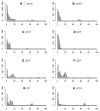Estimating the relative roles of recombination and point mutation in the generation of single locus variants in Campylobacter jejuni and Campylobacter coli
- PMID: 22767048
- PMCID: PMC3985069
- DOI: 10.1007/s00239-012-9505-4
Estimating the relative roles of recombination and point mutation in the generation of single locus variants in Campylobacter jejuni and Campylobacter coli
Abstract
Single locus variants (SLVs) are bacterial sequence types that differ at only one of the seven canonical multilocus sequence typing (MLST) loci. Estimating the relative roles of recombination and point mutation in the generation of new alleles that lead to SLVs is helpful in understanding how organisms evolve. The relative rates of recombination and mutation for Campylobacter jejuni and Campylobacter coli were estimated at seven different housekeeping loci from publically available MLST data. The probability of recombination generating a new allele that leads to an SLV is estimated to be roughly seven times more than that of mutation for C. jejuni, but for C. coli recombination and mutation were estimated to have a similar contribution to the generation of SLVs. The majority of nucleotide differences (98 % for C. jejuni and 85 % for C. coli) between strains that make up an SLV are attributable to recombination. These estimates are much larger than estimates of the relative rate of recombination to mutation calculated from more distantly related isolates using MLST data. One explanation for this is that purifying selection plays an important role in the evolution of Campylobacter. A simulation study was performed to test the performance of our method under a range of biologically realistic parameters. We found that our method performed well when the recombination tract length was longer than 3 kb. For situations in which recombination may occur with shorter tract lengths, our estimates are likely to be an underestimate of the ratio of recombination to mutation, and of the importance of recombination for creating diversity in closely related isolates. A parametric bootstrap method was applied to calculate the uncertainty of these estimates.
Figures


Similar articles
-
Sequence typing and comparison of population biology of Campylobacter coli and Campylobacter jejuni.J Clin Microbiol. 2005 Jan;43(1):340-7. doi: 10.1128/JCM.43.1.340-347.2005. J Clin Microbiol. 2005. PMID: 15634992 Free PMC article.
-
Multilocus sequence typing (and phylogenetic analysis) of Campylobacter jejuni and Campylobacter coli strains isolated from clinical cases in Greece.BMC Res Notes. 2013 Sep 8;6:359. doi: 10.1186/1756-0500-6-359. BMC Res Notes. 2013. PMID: 24010733 Free PMC article.
-
Multilocus sequence typing of Campylobacter jejuni and Campylobacter coli to identify potential sources of colonization in commercial turkey farms.Avian Pathol. 2018 Oct;47(5):455-466. doi: 10.1080/03079457.2018.1487529. Epub 2018 Jul 9. Avian Pathol. 2018. PMID: 29897783
-
The evolution of Campylobacter jejuni and Campylobacter coli.Cold Spring Harb Perspect Biol. 2015 Jun 22;7(8):a018119. doi: 10.1101/cshperspect.a018119. Cold Spring Harb Perspect Biol. 2015. PMID: 26101080 Free PMC article. Review.
-
Campylobacter sequence typing databases: applications and future prospects.Microbiology (Reading). 2012 Nov;158(Pt 11):2695-2709. doi: 10.1099/mic.0.062000-0. Epub 2012 Sep 17. Microbiology (Reading). 2012. PMID: 22986295 Review.
Cited by
-
Despite Shared Geography, Campylobacter Isolated from Surface Water Are Genetically Distinct from Campylobacter Isolated from Chickens.Microbiol Spectr. 2023 Mar 2;11(2):e0414722. doi: 10.1128/spectrum.04147-22. Online ahead of print. Microbiol Spectr. 2023. PMID: 36861983 Free PMC article.
-
Relation between two evolutionary clocks reveal new insights in bacterial evolution.Access Microbiol. 2022 Feb 16;4(2):000265. doi: 10.1099/acmi.0.000265. eCollection 2022. Access Microbiol. 2022. PMID: 35355876 Free PMC article.
-
Speciation trajectories in recombining bacterial species.PLoS Comput Biol. 2017 Jul 3;13(7):e1005640. doi: 10.1371/journal.pcbi.1005640. eCollection 2017 Jul. PLoS Comput Biol. 2017. PMID: 28671999 Free PMC article.
-
Simulating and Summarizing Sources of Gene Tree Incongruence.Genome Biol Evol. 2016 May 9;8(5):1299-315. doi: 10.1093/gbe/evw065. Genome Biol Evol. 2016. PMID: 27017528 Free PMC article.
-
Strain-level genomic variation in natural populations of Lebetimonas from an erupting deep-sea volcano.ISME J. 2014 Apr;8(4):867-80. doi: 10.1038/ismej.2013.206. Epub 2013 Nov 21. ISME J. 2014. PMID: 24257443 Free PMC article.
References
-
- Clark CG, Bryden L, Cuff WR, Johnson PL, Jamieson F, Ciebin B, Wang G. Use ofthe Oxford multilocus sequence typing protocol and sequencing of the flagellin short variable region to characterize isolates from a large outbreak of waterborne Campylobacter sp. strains in Walkerton, Ontario, Canada. J Clin Microbiol. 2005;43:2080. - PMC - PubMed
-
- Dempster AP, Laird NM, Rubin DB. Maximum likelihood from incomplete data via the EM algorithm. J Roy Statist Soc Ser B. 1977;39(1):1–38.
-
- Didelot X, Lawson D, Falush D. Simmlst: simulation of multilocus sequence typing data under a neutral model. Bioinformatics. 2009;25:1442. - PubMed
Publication types
MeSH terms
Substances
Grants and funding
LinkOut - more resources
Full Text Sources


